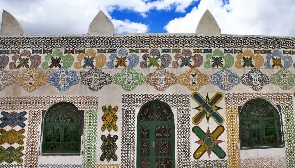 Dutse Palace Art/Photo credit: Hotels.ng
Dutse Palace Art/Photo credit: Hotels.ng
The Dutse Palace art is a testament to the rich cultural heritage of Northern Nigeria. Its intricate designs and motifs are not only aesthetic but hold great significance to the people of the region. One motif, in particular, known as the Northern Knot, is central to the art, and has a special place in the hearts of many due to the political weight and identity it carries. It was popularized by the political elite led by Alhaji Ahmadu Bello, the first premier of Northern Nigeria and holder of the Sokoto Caliphate traditional title of Sarduana.
The northern knot was formally adopted by the ruling class in 1950 when Nigeria was fighting for political independence from Britain. It became a rallying symbol that projected the agenda of “One North” which pushed for representation as well as privileges for Northern Nigeria. It was also used to diffuse the overarching perception of Southern Nigeria’s persecution and political dominance, according to the journal of the international institute.
The northern knot, also known as the “dagin arewa” motif, is one of the most prominent motifs in the Dutse Palace art. It is a symbol of unity and is used extensively in the decoration of the palace. The knot is made up of two interlocking squares, which were arranged to form a diamond shape. The star-like image is said to represent the four corners of the world, while the interlocking squares represent the unity of the people.
It is believed that the knot originated from Christian missionaries in the 15th century. There are other accounts that say it was motivated by the Star of David. Irrespective of historical accounts, the northern knot is not only significant in palace art, but is also used in other aspects of Hausa culture. For example, it is commonly found in the embroidery of Hausa dresses and is used as a symbol of pride and identity. The knot is also used in the decoration of homes and public buildings, and is seen as a way to bring people together.
The art in itself is a product of the Hausa people, who are known for their artistry and craftsmanship. The Dutse palace, located in Garu, Jigawa State, is the seat of the emir of Dutse and is home to some of the most exquisite examples of art. They are created using a variety of materials, including wood, leather, and metal, and are characterized by intricate designs and patterns, according to Daily Trust.
The significance of the northern knot and the Dutse Palace art as a whole cannot be overstated. It is a testament to the rich cultural heritage of the Hausa people and serves as a reminder of the importance of unity and diversity. The art form has survived for generations and continues to inspire artists and craftsmen today. The Dutse Palace art is a true treasure of Northern Nigeria, and the northern knot is a central part of its legacy.